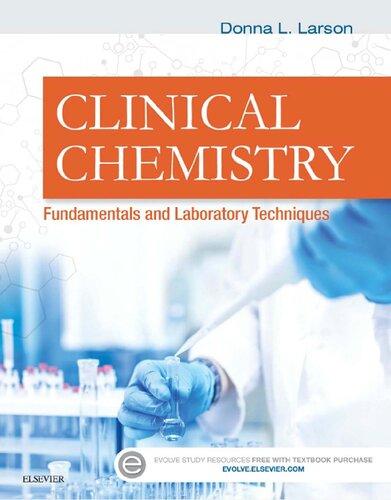ClinicalChemistry
FundamentalsandLaboratoryTechniques
Author DonnaLarson,EdD,MT(ASCP),DLM
VicePresidentforAcademicandStudentAffairs
ClatsopCommunityCollege
Astoria,Oregon
Consulting Editors
JoshuaHayden,PhD,DABCC
AssistantProfessorofPathologyandLaboratoryMedicine
WeillCornellMedicalCollege
Director,ToxicologyandTherapeuticDrugMonitoring
AssistantDirector,CentralLaboratory
NewYorkPresbyterianHospital-CornellCampus
NewYork,NewYork
HariNair,PhD,DABCC
TechnicalDirector
BostonHeartDiagnostics
Framingham,Massachusetts
To my mom and dad, DonaldandBarbara Bedard (I wish they could have been here to see this); to my husband, Earl, and my son, Adrian, for their love and support; to my sister and herfamilyfor their warmth and love; to theAllardsfor their support during my clinicalyear and collegeyears; and to all thefriends and colleagues I worked with at Wentworth-Douglass Hospital (NH), 509th Strategic Hospital (NH), RAFLakenheath Regional Hospital (UK), Winston-Salem State University (NC), MtHood Community College (OR), Portland Community College (OR), and Clatsop Community College (OR)
Donna Larson
Thispageintentionallyleftblank
Clinical Chemistry: Fundamentals andLaboratory Techniques isacomprehensive,readable,andstudent-friendlytextfor 2-yearmedicallaboratorytechnologyprograms.Thetextbookhasafull-colordesignalongwithdetailedillustrations anddiagramstohelpstudentswithcomplexchemistry concepts.Pathophysiologicconceptsareincludedtohelp studentsunderstandtheclinicalrelevanceofclinicalchemistryassays
Purpose and Organization
AsIlookbackatmyjourneyinclinicallaboratoryscience, Icannothelpbutmarvelathowlaboratorytestmethods rapidlychangedoverthecourseofthe20thcenturyand intothe21stcentury.Whileresearchingmydissertation, The Structure ofKnowledge in Clinical Laboratory Science, I wasamazedtoreadarticlesinlaboratoryjournals(1940s) concerninghowtobuildabettercageforlaboratoryanimals.(Pregnancytestsduringthattimeusedrabbitsto determinewhetherawomanwaspregnant.)Theradioimmunoassaysthatwerepopularinthe1970sandintothe 1980swerelargelyreplacedbycolorimetricimmunoassays inthelate1980sand1990s.Lookingback,therewasalways newinformationintheexpandingdisciplineofclinicallaboratoryscienceThemoretheknowledgebaseexpands,the morethestudentsareaskedtolearn.Thisisespeciallytrue ofmedicallaboratorytechnology(MLT)students.
MLTstudentshaveamere2yearstolearnalltheclinical laboratoryscience(CLS)knowledge(withfewprerequisite andgeneraleducationcourses)onwhichtobuildasolid knowledgefoundation.Piecesfromvariousdisciplinesare incorporatedorembeddedintheirCLS.Whenwritingthis book,Ienvisionedaclinicalchemistrybookthatwould incorporatejust-in-timelearningconceptsforwhichthe materialwouldbefortifiedwithadditionalmaterialwhen needed.Buildingonthisapproach,Part1,LaboratoryPrinciples,coverslaboratoryprinciples,safety,qualityassurance,andotherfundamentalsoflaboratorytechniques. Theconceptsareessentialforanyoneworkinginaclinicallaboratory,andthissectionprovidesagoodreference forbeginningMLTstudents.Forexample,thestudents donottakeastatisticscourse,butstatisticalconceptsand calculationsareincludedinChapter7,LaboratoryQualityManagementSystems.Qualitymanagementmethods,
includingtheapplicationsofWestgardrulesforcontrol chartsandthecalculationofthemean,mode,andstandard deviation,areexplainedandpracticedinthatchapter.
Part2,PathophysiologyandAnalytes,coversthediseases,brokendownbybodysystem,thatarecommonly diagnosedthroughchemicaltests.Eachchapterinthissectioncontainsinformationaboutanatomyandphysiology ofaspecificbodysystem,diseasemechanismsofcommon conditionsthatrequireclinicalchemistrytesting,andhow laboratoryresultscorrelatewithclinicaldisorders.Thisisa keysectionofthebookbecauseMLTstudentsusuallydo nothaveroomintheirprogramforaseparatepathophysiologyclass,unlikeotherhealthsciencestudents,forwhomit ispartoftheprogramparadigm.
Pathophysiologicmechanismsofdiseasesandtheresultanteffectsonclinicalchemistrytestsarediscussedineach ofthechapters.Forexample,itiseasiertoremembertest resultsthatareelevatedafteranacutemyocardialinfarction (MI)ifitisknownthatthemuscleisdamagedandthat thedyingcellsreleasespecificchemicalsintotheblood.If bloodisdrawnattimedintervalsaftertheMI,theperson whounderstandsthepathophysiologicmechanismbehind theinfarctwillknowwhattypesofclinicalchemistryresults toexpectfromeachspecimen.
Whendiseasesarediscussedthatdonotuselaboratory testsfordiagnosesorwhenlaboratorytestsareusedto ruleoutotherdisorders,thisinformationisgivensothat studentscanunderstandthelaboratorytestorderingpatternsofhealthcareproviders.Thisinformationalsohelps studentsbetterunderstandreflextestingandhowthealgorithmsaredeveloped.
Part 3, OtherAspectsofClinicalChemistry,covers therapeuticdrugmonitoring,toxicology,transplantation, andemergencypreparedness.Theclinicallaboratoryhasa criticalroleintheseareas,providingongoingtestingand assistance
Tocomplementtheorganization,thebookiswrittenintheactivevoicetohelpstudentsbetterunderstand thematerial.Althoughthismaybeunconventionalfora textbookatthislevel,Ibelieveithelpsstudentstobetter understandcomplexclinicalchemistryconceptsandmasterthematerial.
Mostindividualsarevisuallearners.Tothatend,many figures,photographs,tables,andflowchartsareincluded
tohelpstudentsbetterunderstandconcepts.Manyfigures summarizecomplexandcomplicatedprocessesorpathways toprovidebettercomprehensionofthematerialbystudents.
Key Features
Chapter Outline
Eachchapterstartswithachapteroutlinethatshowsthe maintopicsthatarecovered.Itprovidesstudentsand instructorswitharoadmaptothechapterandcanbeeasily referencedatanytime.
Objectives
Thetextbookformatfacilitatesthelearningprocessbyprovidingstudentsandeducatorswithdetailedobjectivesthat addresstheknowledgerequiredtomastereachchapter's content.Thelearningobjectivesarelistedatthebeginning ofeachchapter,givingstudentsandinstructorsdefinitive evaluationtoolstouseasthechapter'scontentiscovered. Objectivesareprovidedatvariouscognitivemasterylevels:comprehension,application,analysis,synthesis,and evaluation.
KeyTerms
Keytermsareidentifiedatthebeginningofeachchapter andhighlightedinthechapter,puttingvaluableterminologyatstudents'fingertips.Thekeytermsarealsoincluded intheGlossaryatthebackofthebook.
Case in Point
Akeyclinicalcasestudyisprovidedatthebeginningofevery appropriatechapter.TheCaseinPointfeatureprovidesapplicationofthestudent'sknowledgeforcorrelatingtheclinical sideoftestresults.Studentsareaskedtothinkaboutimportantquestionsrelatedtoeachscenarioandtousefundamentalinformationfromthechaptertodeterminetheanswers.
Points to Remember
Abulletedlistofimportantconceptsisincludedinthefirstpart ofthechapter,providinganoverviewofthechaptercontent. Thislistgivesstudentsasimplestudytoolforeasyreference.
Summary
Ashortsummaryattheendofthechapterhighlights keyinformationfromthechapter.Studentscanrevisit thevariouschaptertopicsinshortformforreviewand reinforcement.
Review Questions
Multiple-choicereviewquestionsattheendofeverychapterprovidestudentswithauniquetoolastheypreparefor classroomexaminationsandcertificationexaminations.The reviewquestionsgivestudentsachancetoquizthemselves onthechaptercontent,assesstheirknowledgeofimportant chaptertopics,andevaluatewhichtopicsneedfollow-up review.
Critical Thinking Questions
TheCriticalThinkingQuestionsallowstudentsandinstructorstodiscussthechaptertopicsinabroaderway.Although thesequestionshavecorrectanswers,theyrequiremoreindepththinking,analysis,evaluation,andreflectionthan otherquestionsinthechapter.
Case Studies
AdditionalCaseStudiesroundouteachmostchapters, givingstudentsanotheropportunitytoapplytheknowledgegainedfromthechapter.Thescenariosaremeantto stimulateinterestandcriticalthinkingandtoencourage discussionofchaptertopicswithotherstudents.
Evolve Companion Website
Clinical Chemistry comeswithacompanionwebsite,found onEvolve(evolve.elsevier.com/Larson).Thiswebsitecontainshelpfulancillariesforinstructorsandadditionalmaterialsforstudents
For the Instructor
TheEvolvewebsitehasmultiplefeaturesfortheinstructor:
•Atestbankwithmultiple-choicequestionsandrationales.
• PowerPointpresentationsforeverychapterthatcanbe usedasisorasatemplatetopreparelectures.
•AdetailedAnswerKeywithrationalesforallin-text questions.
•TheImageCollectionthatprovideselectronicfilesofall thechapterfiguresthatcanbedownloadedintoPowerPointpresentations.
For the Student
Additionalcontentisavailableforthestudent:
• High-definitionanimationstoillustratekeyphysiologic andpathophysiologicprocesses
• ExtraCaseStudiesforcertainchaptersformorepractical applicationoftextbookcontent.
Part 1: Laboratory Principles
1 Laboratory Essentials,1
Donna Larson Introduction, 3
History of Clinical Laboratories, 3 Types of Clinical Laboratories, 4 Regulation and Accreditation of Clinical Laboratories, 8 Laboratory Materials, 9 Chemistry Review, 10 Laboratory Mathematics, 14
2 Practical Laboratory Safety,25
Donna Larson Introduction, 26 Safety Regulations, 26
The Laboratory Safety Program, 29
3 Principles of Laboratory Instrumentation,41
Craig Foreback and Donna Larson Introduction, 43 Properties of Light, 43 Spectrophotometry, 44 Fluorometry, 48 Luminometry, 51 Nephelometry andTurbidimetry, 51 Electrochemistry and Chemical Sensors, 52 Chromatography, 56
Mass Spectrometry, 62 Electrophoresis, 67 Colligative Properties, 71 Point-of-CareTesting, 72 Flow Cytometry, 74
4 lmmunoassays,78
Donna Larson Introduction, 80
Antibodies, Antigens, and Analytes, 80 lmmunochemical Methods, 82
Label Methods, 84
Particle Methods, 88
Light-Scattering Methods, 92 Factors Affecting Immunoassay Analytical Performance, 93
5 Molecular Diagnostics,97
Donna Larson Introduction, 98 Nucleic Acid Structure and Function, 98 Laboratory Methods, 106 Diagnostic Applications, 110
6 Automation in the Laboratory,114
Donna Larson Introduction, 115 Goal of Automation, 115 History of Automated Analyzers, 115 Automating Clinical ChemistryTests, 117 Total Laboratory Automation, 119
7 Laboratory Quality Management Systems,124
John W. Ridley and Donna Larson Introduction, 126 Introduction to Quality, 126 Facilities and Safety Overview, 128 Purchasing and Inventory, 130 Process Control, 131 Assessment, 148 Personnel, 149 Customer Service, 149 Occurrence Management, 149 Process Improvement, 149 Documents and Records, 151 Organization, 152
8 Enzymes,156
M. Laura Parnas and Thomas Kampfrath Introduction, 158 The Nature of Enzymes, 158 Kinetics, 159
Enzyme Reaction Conditions, 162 lsoenzymes, 163
Specific Enzymes, 163
Part 2: Pathophysiology and Analytes
9 Clinical Chemistry and Disease,171
Donna Larson Introduction, 172 Definition of Disease, 172
Pathology, 172
Disease Mechanisms, 175
Biochemistry of Disease, 175
10 Cell Injury and Its Relationship to
17 Blood Vessel Diseases,289
Donna Larson
Introduction, 291
Lipids, 291
Lipoproteins, 293 Disease,179
Normal Lipoprotein Metabolism, 294
Donna Larson Abnormal Lipoprotein Metabolism, 296 Introduction, 180 Laboratory Procedures and Limitations, 299
Overview of Cellular Injury, 180 Lipoproteins and Clinical Vascular Disease, 301
Causes of Cellular Injury, 181
Changes in Body Chemistry, 183
18 Heart Disease,306 LaboratoryTests, 184
11 Inflammation,187
Sheryl Berman
Introduction, 307
Heart Structure and Blood Flow, 307
Donna Larson Myocardial Infarction, 307 Introduction, 188 Congestive Heart Failure, 311
Defense Mechanisms, 188 Congenital Heart Defects, 312
The Inflammation Process, 188 Endocarditis, Myocarditis, and Pericarditis, 314
Acute Inflammation, 195
Chronic Inflammation, 196
Laboratory Procedures and Limitations, 198
12 Body Fluids and Electrolytes,204
19 Respiratory Diseases,318
Donna Larson Introduction, 319
Structure and Function of the Respiratory System, 320
Donna Larson Respiratory Diseases and Pathophysiology, 320 Introduction, 205
Fluid Balance and Body Fluid Compartments, 205
Electrolytes, 206
Colligative Properties, 213
Fluid Imbalances, 215
13 Blood Gases and Acid-Base Balance,219
Donna Larson
Introduction, 220
Blood Gases, 220
Acid-BaseTheory, 224
20 Gastrointestinal Disease,334
Sheryl Berman
Introduction, 335
Gastrointestinal System, 335
Gastrointestinal FunctionTests, 342
21 Diseases of the Liver,346
Donna Larson
Introduction, 347
Liver and BiliaryTract, 348
Acid-Base Disorders, 226 Liver Diseases, 350
Interpreting Blood Gas Analyses, 230
14 Blood Diseases,234
Sheryl Berman
Introduction, 236
Hematopoiesis, 236
White Blood Cells, 236
Red Blood Cells, 240
15 Proteins,251
Donna Larson
Introduction, 252
Biochemistry of Proteins, 252
Plasma Proteins, 255
Proteins in Other Body Fluids, 264
16 Cancer and Tumor Markers,268
Donna Larson
Introduction, 269
Cancer andTumor Markers, 269
Clinical Correlations, 280
22 Pancreatic Diseases and Disorders,363
Donna Larson
Introduction, 365
Overview of the Pancreas, 365
Pancreatitis, 366
Diabetes, 368
Cystic Fibrosis, 375
Malabsorption and Maldigestion, 375
23 Endocrinology,379
Jimmy L. Boyd and Donna Larson
Introduction, 382
Overview of the Endocrine System, 382
Anatomy, Pathophysiology, and Laboratory Testing, 385
24
Kidney and Urinary Tract Diseases,412
Sheryl Berman
Introduction, 413
Kidney Anatomy, 414
1
CHAPTER OUTLI NE
Introduction
HistoryofClinicalLaboratories
TypesofClinicalLaboratories
Inpatient Laboratories
Outpatient Clinics and Physicians'Office Laboratories
Reference Laboratories
State and Federal Laboratories
Military Laboratories
RegulationandAccreditationofClinicalLaboratories
Regulation
Accreditation
LaboratoryMaterials
Glassware and Plasticware
Centrifuges
Balances
Pipettes
Reagents
Water
OBJ ECTIVES
At the completion ofthis chapter, the reader will be able to:
1. Describe the history ofthe clinical laboratory.
2. List the typica departments ofa clinica laboratory.
3. List the personnel employed in a clinical laboratory.
4. List the characteristics of reference, federal, and military laboratories.
5. Briefly describeThe Joint Commission and the College of American Pathologists and their roles in clinical laboratory oversight.
6. Describe the types ofwater and the uses for each.
7. Compare and contrast the types ofglassware and plasticware.
8. Describe the types ofcentrifuges used in the laboratory.
9. Describe the operating instructions and precautions for centrifuges.
ChemistryReview
AtomicTheory
Chemical Bonds
Factors Affecting Chemical Reactions
Acid, Bases, and Salts
Organic Chemistry
Biochemistry
LaboratoryMathematics
Molarity
Molality
Normality
Dilutions
Conversions
pH
Beer's Law
Standard Curves
Summary
1 0. Describe the types of balances and their use in the laboratory.
11 Compare and contrast serologic and volumetric pipettes.
12. Describe the various methods used to calibrate pipettes.
13. Define molarity and mole and perform the calculations needed for preparing and working with molar solutions.
14. Define molality and perform the calculations needed for preparing and working with molal solutions.
15. Define normality, equivalent weight, and milliequivalent weight and perform the calculations needed for preparing and working with normal solutions.
16 Define g/dL and mg/dL units and perform calculations necessary to prepare solutions ofa desired g/dL and mg/dL concentration.
certificationagencycreatedbylaboratoryprofessionalsin the1970stocredentiallaboratoryprofessionalsTheASCP BoardofRegistryandtheNCAmergedin2009tocreate theASCPBoardofCertification.
AnotherorganizationthatcertifieslaboratoryprofessionalsandothermedicalprofessionalsistheAmericanMedical Technologists(AMT).TheAMTwasfoundedin1939and isanationallyandinternationallyrecognizedcertification andmembershipsocietyformedicaltechnologists,medicallaboratorytechnicians,phlebotomytechnicians,medical laboratoryassistants,clinicallaboratoryconsultants,medicalassistants,medicaladministrativespecialists,dentalassistants,andalliedhealthinstructors.
In1933,clinicallaboratorytechniciansformedaprofessionalsociety,theAmericanSocietyforClinicalLaboratory Technicians,toprovideautonomyandavoiceforthegrowingprofessionofclinicallaboratoryscience.Yearslater,the organizationchangeditsnametotheAmericanSocietyfor MedicalTechnologyandthentotheAmericanSocietyfor ClinicalLaboratoryScience(ASCLS).
Inthe1940sand1950s,clinicallaboratorytestinganalyzed specimenssuchasbloodandurine.Laboratoriesalsohoused andusedanimalsinthetestprocedures.Anexampleisthe pregnancytestwhereurinefromawomansuspectedofbeing pregnantwasinjectedintoarabbit.Afteraspecifictimeperiod, therabbit'sovarieswereexaminedforovulation.Iftheovaries wereswollenandovulating,thewomanwaspregnant.Inthe 1960s,laboratoriesusedfrogstodetectpregnancyinwomen. Bythe1970s,morereliableandvalidtestprocedureswere introducedintotheclinicallaboratoryforpregnancytesting. Moresensitivetestprocedureswereintroducedinthe1970s (e.g.,radioimmunoassay)and1980s(e.g.,enzymeimmunoassays)Bioluminescenceassaysattainedwidespreaduseinthe 1990s.Asmoresensitivetestprocedureswereintroducedinthe clinicallaboratory,moretestanalyseswereadded.
Types of Clinical Laboratories
Clinicallaboratoriesareadynamicareainhealthcare.Laboratoriesproduce80%oftheobjectivedatathathealthcare providersusetodiagnoseandruleoutdiseases,toprovide bloodfortransfusion,andtodeterminethesusceptibilityof pathogenicbacteriatoantibiotics.Clinicallaboratoriesare foundinhospitals,outpatientclinics,andphysicians'offices andasstand-alonereferencelaboratoriesLaboratoriesare constantlyintegratingnewtechnologyandinstrumentsto bettermeettheneedsofhealthcareprovidersandpatients Thefollowingsectionsdescribethetypesofclinicallaboratories,structuresoforganizationsandlaboratories,laboratorypersonnel,andlaboratorydepartments
Inpatient laboratories
Clinicallaboratoriesbeganaspartofahospitalintheearly 20thcenturyandremainacriticalpartofhospitalstoday. Althoughtheclinicallaboratorymaybelocatedinthehospital,workfromoutpatientclinics,nursinghomes,and
othersettingsmaybesenttothehospital'sclinicallaboratoryforanalysis.Clinicallaboratoryworkersarehospital employees,andtheyareanimportantpartofthehealth careteam.
Organizational Structure
Hospitalsareaninventionofthe20thcentury.Hospitals wereknownasalmshousesbeforethe20thcentury.Almshouseswereplaceswherepoorpeopleorpeoplewithoutfamilymemberstocareforthemwouldgotoreceivecare.These facilitiesprovidedfood,shelter,andrest.Beforethe20thcentury,thebestmedicalcarewasreceivedathome;evenoperationswereperformedinthehome.Asmedicalprocedures andequipmentbecamemoreadvanced,thepatientwentto seethedoctorinsteadofthedoctorcomingtoseethepatient.
Hospital
Thereareapproximately6500hospitalsintheUnitedStates. Theyareclassifiedaspublic,private,specialty,community, federal,military,orothertypes.
Hospitalsareorganizedinthreedistinctparts:governingboard,medicalstaff,andmanagement.The governing board isthebodyresponsibleforthefinancialhealthofthe organizationandforsettinginstitutionalpoliciesandgoals. Thegoverningboardappointsthemedicalstaffastheparty responsibleforqualitypatientcare.
The medical staff membersofthehospitalarenotusuallyconsideredtobeemployees;however,morehospitals andhospitalsystemsareemployinghealthcareproviders. Inthetraditionalstructure,themedicalstaffisgranted therighttoadmitpatientsandperformproceduresinthe hospital.
Themanagementportionofthehospitalconsistsof thehospitaladministratorasthechiefexecutiveofficer whoisresponsibleformanagingallhospitaldepartments Figure1-1showstherelationshipsamongthethreeparts ofthehospitalandshowswherethelaboratoryfitsintothe organizationalstructure.
Clinical Laboratory
ClinicallaboratoriesarecomposedofmanydifferentdepartmentsThelaboratoryservicesdepartmentisusuallyseparatedintoanatomicandclinicalpathology.The anatomic pathology departmentexaminesalltissues,fluids,organs, andlimbsremovedfromthebody.Thisdisciplinecomprisessurgicalpathology,histology,andcytology.Personnel intheanatomicpathologydepartmentincludepathologists, pathologists'assistants,histologytechnicians,andcytology technicians.Intheanatomicpathologydepartment,tissuesaredescribedbypathologists,cutintosections,fixed withchemicals,slicedverythin,placedonglassslides,and stainedwithspecialchemicals.Aftertheslidesarestained andcoverslipped,thepathologistexaminesthetissuefor abnormalities.
Clinical pathology isthelargestportionoftheclinical laboratory.Thissectioniscomposedofhematology,clinical chemistry,microbiology,immunohematology,toxicology,
MedicalRecords Admissions
ClinicalLab Radiology Imaging
Hospital Administrator Respiratory Pharmacy Rehabilitation
Facilities Administrative Support
Business Office Coding Billing&Accounting HumanResources
Hematology
• Figure 1-1 Hospital organizational chart.
Immunology/ Serology Microbiology
• Figure 1-2 Clinical laboratory organizational chart.
immunologyandserology,urinalysis,specimencollection, andcustomerserviceTheindividuallaboratorysectionsare describedlater(Fig.1-2).
Departments and Their Functions
Clinical Chemistry
Clinicalchemistryisthemedicaldisciplinethatusesvarious methodsofanalysisandinstrumentationtodeterminevaluesforchemicalcomponentsinnormalanddiseasedstates, typesandconcentrationsofbloodtoxins,andtherapeutic druglevels.Routinetestsrunbytheclinicalchemistrysection analyzelevelsofglucose,bloodureanitrogen(BUN),electrolytes,calcium,phosphorus,magnesium,lipids,liverfunction values,alkalinephosphatase,creatininekinase,creatinine, protein,albumin,andhemoglobinA1c.Theclinicalchemistrydepartmentalsorunshepatitispanels,testsforrubella andhumanimmunodeficiencyvirus(HIV),anddetermines levelsofantibodiesintheblood.Hormonelevels(e.g.,thyroid-stimulatinghormone, prolactin, follicle-stimulating hormone)aretestedinanothersectionofthislaboratory. Theroutinetestsareusuallyruninthemainclinical chemistrydepartment.Theantibodyandhormonelevels areusuallyconsideredsubspecialties.Othersubspecialty departmentsincludethetoxicology,therapeuticdrugmonitoring,moleculardiagnostics,andfecalanalysis.Some clinicalchemistrylaboratorieshaveasectionthatanalyzes bloodgases.
Hematology
ToxicologyIIUrnalysis
Hematology isthestudyofbloodcells.Bloodcellsinclude erythrocytes(i.e.,redbloodcells),leukocytes(i.e.,white bloodcells),andthrombocytes(i.e.,platelets).Themost commontestperformedinthisdepartmentisthecompletebloodcount(CBC),whichisasummaryofcell counts(i.e.,red,white,andplatelet),totalhemoglobin level,redbloodcellsize,andhematocrit.ACBCusually includesadifferentialcount,whichreportsthepercentage ofeachtypeofwhitebloodcellinthebloodsample.Cell countsforbodyfluidsarealsoperformedinthisdepartment.Othertestsincludereticulocytecountsanderythrocytesedimentationrates.
Inmanylaboratories,coagulationtestingisperformed inthehematologydepartment.Routinecoagulationtests includetheprothrombintime(PT)andtheactivatedpartialthromboplastintime(aPTT)Thesetestsassessthetwo majorclottingpathwaysinthebody.
Microbiology
The microbiology department identifiesmicroorganismsthatcausediseaseanddeterminethemosteffective antibiotictodestroybacterialpathogens.Thisdepartment growsculturesfrommajorbodysystemssuchasthethroat, urine,stool,wound,blood,eyes,ears,bodyfluids,nasal, abscesses,vagina,urethra,andtissues.Surgeonsoftenperformacultureaftertheydrainordebrideaninfectedarea.
Military Laboratories
TheDepartmentofDefenseoperatesmanyclinicallaboratoriesacrosstheworld.MilitaryhospitalsperformroutinelaboratorytestingandareaccreditedbytheCollegeof AmericanPathologists(CAP).Theverylargemilitaryhospitalsperformroutinetestsforthephysiciansassignedtothat hospitalandspecializedtestsforothermilitaryhospitals aroundtheworld.
MilitaryhospitalsoperateAmericanhospitalstotreatmilitarymembersandtheirdependentsMilitaryhospitalshave laboratoryofficersandmedicallaboratorytechniciansstaffing theclinicallaboratory.Laboratoryofficershaveatleastabachelor'sdegreeandCLScertification,andtheenlistedmembers serveasmedicallaboratorytechniciansandaregraduatesof theservice'smedicallaboratorytechnicianschool.
Regulation and Accreditation of Clinical Laboratories
Federalregulationsandaccreditationagenciesgovernthe operationofclinicallaboratories.Federalregulationsthat affectclinicallaboratoriesincludethe Clinical Laboratory Improvement Act (CLIA)of1967andtheClinicalLaboratoryImprovementAmendmentsof1988,the Needlestick Safety and Prevention Act of 2000, andthosefor bloodborne pathogens, hazardous chemicals, and hazard communications. Theregulationsconcerningsafetyare discussedinChapter2,andCLIAisdiscussedinthenext section.TheHealthInsurancePortabilityandAccountabilityActaffectsthelaboratoryasitrelatestopatientprivacy.
Regulation
CongressfirstpassedtheCLIAin1967.Thepurposeof thisActwastoregulateclinicallaboratoriesinvolvedin interstatecommerce.Hospitalandreferencelaboratories weretheonlyclinicallaboratoriesaffectedbytheAct.In 1988,CongresspassedregulatoryamendmentstotheAct inresponsetopublicconcernaboutthequalityofPap smearsTheprovisionsofCLIA1988governtheactivities ofalllaboratories.Itwasdesignedtoenhancethequality oflaboratoryservicesprovidedtoallpatientsbymandating qualitycontrol,qualityassurance,andproficiencytesting. Trainedpersonnelwererequiredtoperformparticularlevels orcomplexitiesoftests.Themorecomplextestsalaboratoryperforms,thehigherthestandardsrequiredforthepersonnelworkinginthatlaboratory.Ifalaboratoryperforms onlysimpletests,thelaboratorycanobtainacertificateof waiver.Laboratoriesperforming"waived"testsareexempt fromproficiencytestingrequirementsunderCLIA.
Accreditation
Accreditationisavoluntaryprocessbywhichlaboratoriesmaintaincertainstandardsofquality.Twoaccrediting
agencieshavebeengiven"deemedstatus"bythefederal government'sCentersforMedicareandMedicaidServices (CMS)Iflaboratoriesareaccreditedbyeitheragency,the laboratorydoesnotneedtobeinspectedbytheDepartment ofHealthandHumanServices.Thetwoaccreditingagenciesare TheJoint Commission andthe College ofAmerican Pathologists (CAP).
TheJoint Commission
TheJointCommission(formerlyknownastheJointCommissionfortheAccreditationofHealthcareOrganizations [JCAHO])accreditshospitalsandmanyotherhealthcare organizations,suchasambulatorycarefacilities,standalonesurgerycenters,long-termcarefacilities,behavioral healthcenters,andlaboratories.Ateamofindividuals frompeerinstitutionsthatareaccreditedbyTheJoint Commissionvisitsaninstitutionseekingaccreditationor reaccreditation.Thesesitevisitorsexamineeachstandard andtheevidencecompiledbytheinstitutionforcompliancewiththestandard.Institutionsmustalsocollect dataoncoremeasures(ORYX)andmustcomplywiththe NationalPatientSafetyGoalsannuallyissuedbyTheJoint Commission.TheJointCommissionacceptsaccreditation bytheCAPasevidenceofcompliancewithagoodportion oflaboratorystandards
College ofAmerican Pathologists
TheCAPisaninternationallyknownagencythataccredits clinicallaboratories.Clinicallaboratoryprofessionalsperforminspectionsatclinicallaboratoriesusingaccreditation checklistsdevelopedbyCAP.CAPstrivesforexcellence wellbeyondregulatorycompliancetoassistphysiciansin providingthebestpatientcarepossible.Thefoundationof CAPaccreditationisrigorousaccreditationstandardsthat aremoldedintospecific,comprehensivechecklistsThe inspectionteamusesthecheckliststoanalyzelaboratory operations.
Proficiency Testing
Proficiency testing isrequiredbyCAP,TheJointCommission,andthefederalgovernmentthroughCLIA1988.Proficiencytestingisaprocessinwhichalaboratoryisprovided samplestoanalyzewitharegularrun.Thesesamplesare providedforeverydepartmentinthelaboratorythatperformsdiagnostictests.Thelaboratoryanalyzesthesamples andthensendstheresultsbacktotheagencythatprovided thesamplesTheagencyanalyzesthelaboratory'sresultsand providestheanalysistothelaboratory.Thisprocessteststhe accuracyoflaboratoryresultsbeingproducedinthatlaboratory.Excellentclinicallaboratoriesmustproduceaccurate andreliablelaboratorytestresults.
Competency Testing
Competencytestinginvolvestestingtheabilityofthelaboratoryprofessionalswhoperformthediagnostictests.This mustoccuryearlytoensurethatindividualsperforming diagnostictestsarewelltrainedandcompetent.


























